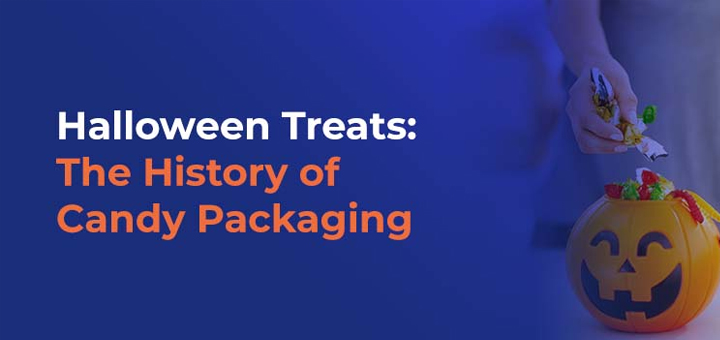Candy was not always a Halloween tradition. In the past, trick-or-treaters expected nuts, coins, toys and other gifts when they knocked on their neighbors’ doors. Although candy marketers initially missed out on the potential of Halloween for candy sales, candy became the standard Halloween treat by the 1970s. In 2021, the National Retail Federation expects consumers to spend $3 billion on Halloween candy.
Candy is essential to a modern American Halloween, and candy packaging has evolved alongside candy’s evolution as an important Halloween treat. While packaging protects the candy bars from damage during transportation and storage, companies have also realized its marketing potential. Read more to learn about the history of Halloween candy and candy packaging.
HOW CANDY BECAME A HALLOWEEN TRADITION
Today, we know Halloween for parties, trick-or-treating, costumes and plenty of candy. However, Halloween’s origins in the Middle Ages, and even its rise in the U.S., look much different than modern festivities. Halloween has transformed from a night of paying respects to the dead and playing pranks to the holiday we know and love today.
Halloween’s Celtic Origins
Although we know Halloween today for a plethora of candy, trick-or-treating and other festivities, the holiday originates from the Celtic celebration of Samhain. The Celts, who lived 2,000 years ago, believed the dead could return to the land of the living on the night of Oct. 31. Although they would pay their respects to the deceased with bonfires and sacrifices, villagers would also dress animal-skin disguises and leave food offerings to drive away phantoms and unwanted spirits.
In the Middle Ages, people became more sophisticated with their costumes, dressing as ghosts, demons and monsters. They also frequently went mumming, where they would perform various tricks and pranks for food and drink. Essentially, mumming resembles today’s trick-or-treating practices.
After the spread of Christianity to the Celts in 1000 A.D., Nov. 2 became All Souls’ Day to honor the dead. Children would go “souling” to ask for gifts of food and money from houses in return for praying for the souls of the household’s deceased relative. Young Scottish and Irish people would also participate in “guising,” where they would wear costumes to perform some sort of trick, like poetry or a song, to receive a reward of fruit, nuts or coins.
Halloween’s Rise in the U.S.
Large numbers of Scottish and Irish immigrants moved to the U.S. in the late 19th and early 20th centuries. Although communities tried to bring back old Celtic traditions, young people took over the holidays in the 1920s and 30s by getting into trouble on Halloween night. Although some people theorize that pranks and mischief might have contributed to the rise of organized trick-or-treating in the 1930s, the practice didn’t really become common until after WWII, when the government lifted sugar ration regulations.
However, in the late 1940s and early 1950s, trick-or-treating looked much different than it does today. Kids would go door-to-door in costumes to receive treats like coins, nuts, fruit, cakes, toys and — of course, candy. Candy marketers had previously overlooked Halloween as an opportunity to sell candy. Instead, Easter and Christmas were the prime candy holidays.
Although the candy industry even tried to create a Candy Day in 1916 to help bolster fall candy sales, they didn’t think to market candy during Halloween. However, in the 1950s, candy finally became a dominant treat to give out during Halloween. By the 1970s, candy became the convenient, economical and expected trick-or-treating treat. Parents also started preferring commercially wrapped candies, as homemade or unwrapped products had a higher chance of tampering.
THE HISTORY OF CANDY PACKAGING
Candy packaging has come a long way from its early days of glass jars and containers. The history of candy packaging includes the rise in popularity of fun-size candy bars and how the purposes of candy packaging have evolved.
Early Candy Packaging
Although we don’t know the exact origins of candy wrappers, candy packaging protects candy from damage while providing a marketing opportunity for candy companies. In the 1800s, candy merchants used pressed-glass candy containers. These containers were inexpensive, and many types of candy were small, round and easy to pour into the glass jars and bottles. Figurines took many shapes, including historic shapes like the Liberty Bell or comic figures like Felix the Cat.
When candy first became a popular choice for Halloween treats, homes would give out full-sized candy bars rather than today’s fun-size options. For example, the candy company Brach’s marketed packages of candy corn with about 40 or 50 pieces of candy. Today, similar packages might include a maximum of 10 pieces of candy.
The Rise of Fun-Size
Modern trick-or-treaters typically expect to receive today’s fun-size candy bars and packages on Halloween night — although strategic children might target the houses and neighborhoods that typically give out full-size treats. Smaller-sized candy bars prove to be a more affordable option, and trick-or-treaters can haul their candy on Halloween night with more ease.
Smaller candy bars, often called fun-size, originated with the Curtiss Candy Company’s buddie- and junior-sized candy bars in the 1930s. Hershey also started selling its Miniatures in 1939. Mars didn’t begin producing its own junior-sized candy bars until the early 1960s. However, Mars started selling slightly larger fun-size candy bars in 1968. Curtiss picked up on the advantages of fun-size candy bars and also started using the term. While Mars sued Curtiss and lost, Mars still holds a trademark on the wording.
Purposes of Candy Packaging
The most apparent purpose of candy packaging is to protect the product from heat, moisture or harmful microbes from prolonged shelving. Candy packaging also ensures the candy maintains its structure during transportation and storage. Modern wrappers also use airtight sealing to preserve and protect candy from tampering. Packaging also communicates crucial information to consumers like nutrition facts, potential allergens and other information and regulations from the government and candy companies.
Candy packaging is also an essential part of the marketing process. In 1890, Milton S. Hershey created the nickel bar. Hershey’s factory is now one of the best-known candy companies in the world. Its rise in popularity encouraged other companies to reconsider their own candy packaging design. Other candy manufacturers realized packaging was a prime opportunity for marketing their product and catching the consumer’s eye.
CONTACT QPSI FOR YOUR PACKAGING NEEDS
For more than 40 years, QPSI has helped the retail and consumer goods industries with their packaging and supply chain management needs. Our expert team’s mission is to provide quality customer service at competitive prices. We practice a company culture of continuous improvement and provide a safe, clean and encouraging work environment, so our staff is ready to serve you.
Contact QPSI today to learn more about our solutions and find the closest location to you!






